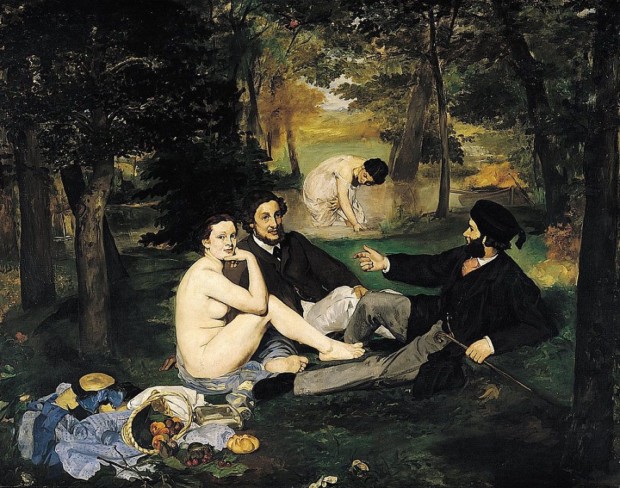Before discussing how the male gaze affects the art world and pop culture we must first break down and understand what it is. The male gaze is a feminist theory that conveys how women are viewed in the eyes of men through visual arts and in literature. This perspective is usually from a masculine and heterosexual frame of reference that aims to display and represent women as simply sexual objects of pleasure for men and their egos.
This gaze suggests a sexualized one that empowers men by automatically materializing women. John Berger explains this best, “Men act and women appear. Men look at women. Women watch themselves being looked at. This determines not only relations between men and women but also the relation of women to themselves. The surveyor of the woman in herself is male: the surveyed female. Thus, she turns herself into an object- and most particularly, an object of vision: a sight (Berger 47). This attitude has permeated the art world in every aspect since visual expression went into practice. It isn’t surprising given the fact that the world is globally patriarchal. Berger said women appear just for men to gaze at them and this is evident in many nude paintings; the men are usually fully dressed while the woman or women are fully naked and gazing into the eyes of the viewer. This rule seems to be one sided.
According to Berger, “the mirror was often used as a symbol of vanity of women,” (Berger 51) if women look at themselves then they are seen as vein because whatever she does or acts out shows how she wants to be treated by others surveying her; in other words, “she turns herself into and object” meant to be viewed. This particular idea is extremely relevant today. Presently, women no longer have to stare into a mirror to be considered vein, they can do so by just wearing clothing that men find attractive- an unsolicited invitation to gawk. This ties in perfectly with Bell Hook’s definition of patriarchy and whether solicited or not, it is a male’s given right.
By dictionary definition, patriarchy means something in relation to a society or community that is governed or organized by men on patriarchal lines and this system of society largely excludes women. Bell Hooks describes patriarchy, “as a political social system that insists that males are inherently dominating, superior to everything and everyone deemed weak, especially females, and endowed with the right to dominate and rule over the weak and to maintain that dominance through various forms of psychological terrorism and violence” (18 Hooks). Here, it seems like Hooks is critiquing society’s appraisal of men that forces them to act so aggressively and outwardly like its acceptable; however, the emphasis on changing this perception is still not heavily placed on men as it is on women.
For example, it is not okay for men to gaze at women and openly comment on their bodies and excuse themselves on the basis of provocative dress soliciting them to do so. Hooks explanation of this male notion is that, “patriarchal ideology brainwashes men to believe that their domination of women is beneficial when it’s not” (27 Hooks).
Okay cool, so men think that they’re always helping even when they are contributing to the problem but there still isn’t a spoken solution. Hooks goes on to explain how men feel weakest when they don’t feel themselves in control but how are we to overcome this when this pattern of domination has continued for so many years? Yes, we are working at recognizing more women artists and allowing women to come forth but all in the name to make men understand. This is hard to do when the fact of the matter is that “sex sells” and every ad, commercial, movie, etc. is geared toward the male gaze. If one was to just evaluate social media alone, all the women that have millions of followers and thousands of likes are those who show their bodies- appeal to the eyes of men. Women are constantly on display and their appearance unconsciously deems their positions in the world. Having the smarts no longer wins the race but having an attractive face and a fit or plastic body image gets you right to the top.
Related image
This is a gym advertisement with a woman who is fit and has a slightly revealing gym outfit on, could be for the purpose of getting the male's attention who is also working out.
Even when selling women’s products, the male gaze is utilized. It seems like nothing is sold off the strength of directly benefiting the female recipient. Nail salon technicians will very strongly suggest bold colors like seductive reds and fiery oranges couples with long nails because those combinations “will get you a boyfriend.” It all is so comical. Even the gyms support patriarchy; this is why so many people are uncomfortable being in that setting. Yes, the overall purpose of working out underlies health benefits but the ads usually show under dressed women with super fit and small bodies next to a strong overpowering male physique.
Of course I disagree with John Berger’s notion of women being the chair men sit on at the table and I agree with Bell Hooks explanation of why men are this. Nonetheless, besides spreading awareness I believe it takes a tougher woman to continue to face the challenges of everyday life for herself instead of for her male counterparts.
Serving as an afterthought: If there were two worlds separated by visitation rights (one with males and the other with females), what would then be the motive for vendors? Would men still be used to promote women’s products? Would female attraction be used to promote male products?

No comments:
Post a Comment